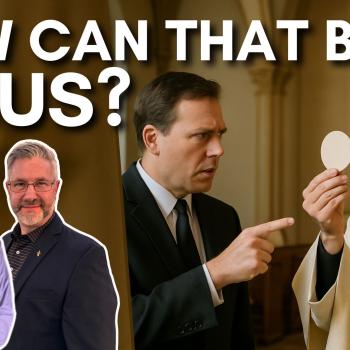Gavin Ortlund is a Reformed Baptist author, speaker, pastor, and apologist for the Christian faith. He has a Ph.D. from Fuller Theological Seminary in historical theology, and an M.Div from Covenant Theological Seminary. Gavin is the author of seven books as well as numerous academic and popular articles. For a list of publications, see his CV. He runs the YouTube channel Truth Unites, which seeks to provide an “irenic” voice on theology, apologetics, and the Christian life. See also his website, Truth Unites and his blog. His words will be in blue. I use RSV for Bible passages.
*****
I’m responding to Gavin’s article, Why Not Grandchildren? An Argument Against Reformed Paedobaptism (Themelios, Vol. 45, No. 2 (2020): 333–346. Themelios is “an international, evangelical, peer-reviewed theological journal that expounds and defends the historic Christian faith. Its primary audience is theological students and pastors, though scholars read it as well.” So this is a “serious” scholarly / academic article. Gavin, as a Reformed Baptist, adheres to an adult, “believer’s” baptism, and this is his argument against one particular Reformed Presbyterian case for infant baptism, by virtue of the analogy to circumcision.
B. B. Warfield gave a helpfully succinct summary of the Reformed case for paedobaptism:
The argument in a nutshell is simply this: God established His Church in the days of Abraham and put children into it. They must remain there until he puts them out. He has nowhere put them out. They are still then members of His Church and as such entitled to its ordinances. Among these ordinances is baptism, which standing in similar place in the New Dispensation to circumcision in the Old, is like it to be given to children.
This article probes these words standing in a similar place. How similar, precisely? Typically, Reformed paedobaptists describe this similarity as one of identity, or near identity. John Calvin, for example, asserted that “whatever belongs to circumcision pertains likewise to baptism … baptism has taken the place of circumcision to fulfill the same office among us.” John Murray claimed that “there is an essential identity of meaning” between circumcision and baptism. Geoffrey Bromiley used the word “equation” to describe the relationship between the two rites.
Gavin didn’t mention that this broad Reformed paedobaptist argument is ultimately drawn straight from St. Paul:
Colossians 2:11-13 In him also you were circumcised with a circumcision made without hands, by putting off the body of flesh in the circumcision of Christ; [12] and you were buried with him in baptism, in which you were also raised with him through faith in the working of God, who raised him from the dead. [13] And you, who were dead in trespasses and the uncircumcision of your flesh, God made alive together with him, having forgiven us all our trespasses,
I have summarized this motif as follows:
Paul in Colossians 2:11-13 makes a connection between baptism and circumcision. Israel was the church before Christ (Acts 7:38; Rom 9:4). Circumcision, given to 8-day old boys, was the seal of the covenant God made with Abraham, which applies to us also (Gal 3:14, 29). It was a sign of repentance and future faith (Rom 4:11). Infants were just as much a part of the covenant as adults (Gen 17:7; Deut 29:10-12; cf. Mt 19:14). Likewise, baptism is the seal of the New Covenant in Christ. It signifies cleansing from sin, just as circumcision did (Deut 10:16; 30:6; Jer 4:4; 9:25; Rom 2:28-9; Phil 3:3). Infants are wholly saved by God’s grace just as adults are, only apart from their rational and willful consent. Their parents act in their behalf.
John Calvin wrote:
Paul . . . adds that the Colossians had been buried with Christ through baptism [Col 2:12]. By this he means that baptism is today for Christians what circumcision was for the ancients. (Institutes of the Christian Religion, edited by John T. McNeill, translated by Ford Lewis Battles, Philadelphia: Westminster Press, 1960, Book IV, ch.14, sec. 24; v. 2, 1300)
Calvin also noted that the analogy (like most analogies) was not a complete one:
But since before baptism was instituted God’s people had circumcision instead, let us examine how these two signs differ from each other, and in what respects they are alike. From this will appear the anagogic relationship of one to the other. (Ibid., Book IV, ch. 16, sec. 3, entitled “Circumcision and Baptism,” v. 2, 1325-1326; editor’s note: “Calvin regards circumcision anagogically as the anticipation of baptism.”)
The editor of this standard version of Calvin’s Institutes cites the same comparison in St. Augustine, City of God, Book XVI, ch. 27, and in Protestant theologian Oscar Cullmann, Baptism in the New Testament, ch. 4. Additionally, Lutheran theologian Philip Melanchthon makes the same argument in his Loci Communes [1555 edition], ch. 21). My reply will be along the same lines as Calvin’s: focusing on the disanalogies involved, which lie next to the analogies.
. . . a credobaptist can agree with Warfield that baptism is “similar” to circumcision, but will take this similarity as most paedobaptists take the relation of the Passover meal and the Lord’s Supper, in that one fulfills the other but not in so identical a manner as to justify paedocommunion.
It seems at first glance that this argument is implausible, seeing that — arguably — the biggest thing that circumcision and infant baptism have in common is the fact that both are done to very young children. I don’t see how that aspect can be removed, without wrecking the analogy altogether. It would no longer be an analogy, I submit.
I offer a further objection to the Reformed paedobaptist argument . . . that the practice of baptizing the infant children of believers is not, in fact, identical with the practice of circumcision throughout the Old Testament.
It is in the sense of being an “initiation rite” into the believing community, of very young children, along with several other similarities that I summarized above.
. . . the problem is not simply with the equation of baptism and circumcision, but with how circumcision has been construed in the first place.
Okay; let’s see what Gavin comes up with.
The proper subjects of circumcision are identified in Genesis 17:9 as “you (Abraham) and your seed after you, for the generations to come.” The “children” in view here (Hebrew זֶרַע , “seed,” [KJV], or “offspring” [ESV], or “descendants” [NIV, NASB, RSV]) are the inter-generational descendants of Abraham that would comprise the nation of Israel. Hence the words “for the generations to come” here, and “every male throughout your generations” a few verses later in Genesis 17:12. It is to this national and intergenerational body that God commands: “every male among you shall be circumcised” (Genesis 17:10).
Sure; but that is the analogy to the Church of Christ; not a perfect one, but close enough to be a forerunner or type of what was to come: similar to many Old Testament precursors to the new covenant and Church age.
Thus, the “children” to whom circumcision was pledged are something less than identical to the “children” envisioned by paedobaptism. The lines of covenant throughout the Old Testament were not drawn around particular believing households within Israel, but around the national family of Abraham that comprised an intergenerational people. It was not the spiritual or covenantal status of the mother and/or father of an infant Israelite boy, in itself, that established their right to circumcision, but rather their identification as the “offspring” (זֶרַע ) of Abraham.
This lines up with the NT vision of the Church eventually incorporating the entire world, or at least seeking to do so. “Go into all the world and preach the gospel to the whole creation” (Mk 16:15). I don’t see how it disproves the analogy. The Jews were the chosen people, after all, so the analogy to the Church would be those who have yielded their lives to God as His disciples. They then become in effect the “new [or additional] chosen people.” “God chose you from the beginning to be saved, . . .” (2 Thess 2:13).
This raises the question: if the basis for infant baptism is infant circumcision, and infant circumcision was practiced intergenerationally, should not infant baptism be practiced intergenerationally as well? In other words, why should the grandchildren of believers not be considered eligible for baptism? Consider the following scenario: John Sr. is a devout believer in a particular paedobaptist church; John Jr. attends the church semi-regularly but has never personally professed faith in Christ or become a member, though he attends church nominally; John III is one week old. Should John III be considered a member of the church and a proper candidate for baptism? Most contemporary paedobaptists say no to this question, while historically, more have said yes (more on that a bit later).
But if the argument for baptizing infants arises from continuity with circumcision, why not baptize grandchildren (and great grandchildren, etc.) of believers? On what basis do we differentiate the covenantal status of John Jr. and John III?
This is the heart of Gavin’s argument, per the title. I think this ties in to the question of religious freedom. As the “stand-in” for John III, John Jr. decides whether to baptize his son or not. It comes down to what the parent believes. It’s their right to raise their children as they so choose. The grandparent can’t supersede that. God’s grace can find ways to positively affect an unbaptized child.
To get from “you and your seed after you for the generations to come” to “those who believe and their children” is not the continuation of an established practice. It is a movement, a development, a change.
That’s correct. This is the portion of the comparison that is a disanology; while there are relatively more elements that are analogous. It’s still enough of an analogy overall to be considered a development of how children become initiated into the believing community or the “kingdom of God.” The Old Testament had the similar notion of “kingdom of priests and a holy nation” (Ex 19:6) and “The LORD has established his throne in the heavens, and his kingdom rules over all” (Ps 103:19) and “Thy kingdom is an everlasting kingdom” (Ps 145:13; cf. Dan 4:3; 7:14, 18, 22).
There is a sense in which credobaptists can affirm a stricter continuity between the old and new covenants than paedobaptists insofar as they designate the church as the “children of Abraham”—defined in the Genesis 17:9 sense during the old covenant, and defined in the new covenant in the sense of Galatians 3:7: “it is those of faith who are the sons of Abraham” (cf. Philippians 3:3, Romans 2:29). This is a continuity that also embraces typological movement and fulfillment.
Belief and faith is central in both belief-systems. It’s just that the believing parents “stand in” for the infants and God extends (supernatural) blessings to the children, without their knowing what is going on. There are numerous scenarios where someone prays for another, in a state of unconsciousness (say, a coma) or, for example, severely disabled, where the recipient doesn’t know what is happening. The disciples raised the dead, according to the gospels. When that happened, it was all because of people completely separate from the dead person, extending God’s power and grace. Ditto with infant baptism. St. Paul refers to “future faith”:
Romans 4:9-13 Is this blessing pronounced only upon the circumcised, or also upon the uncircumcised? We say that faith was reckoned to Abraham as righteousness. [10] How then was it reckoned to him? Was it before or after he had been circumcised? It was not after, but before he was circumcised. [11] He received circumcision as a sign or seal of the righteousness which he had by faith while he was still uncircumcised. The purpose was to make him the father of all who believe without being circumcised and who thus have righteousness reckoned to them, [12] and likewise the father of the circumcised who are not merely circumcised but also follow the example of the faith which our father Abraham had before he was circumcised. [13] The promise to Abraham and his descendants, that they should inherit the world, did not come through the law but through the righteousness of faith.
St. Peter seemed to refer to something similar on the Day of Pentecost:
Acts 2:38-39 And Peter said to them, “Repent, and be baptized every one of you in the name of Jesus Christ for the forgiveness of your sins; and you shall receive the gift of the Holy Spirit. [39] For the promise is to you and to your children and to all that are far off, every one whom the Lord our God calls to him.”
The notion of households being baptized is also a similar thing (Acts 16:15, 33-34; 18:8; 1 Cor 1:16; cf. Gen 18:19; “as for me and my house, we will serve the LORD”: Josh 24:15).
But it is difficult to regard eligibility for circumcision as conditional on the faithfulness of one’s parents.
It’s no more difficult than regarding eligibility for believer’s baptism as conditional on the faith of the one seeking baptism. In each case it’s a free will decision. Parents make lots of decisions on behalf of their children who are too young to make them. Why not include spiritual things in that category? God desires that all come to repentance and salvation (2 Pet 3:9) but not all do because of free will. If God honors that free choice, so must we. We can hope and pray that any individual person will be saved (with baptism as a big part of that, since it regenerates), but God’s allowance of human free will precludes the possibility that all will be.
No, Joshua 5:8 records that the entire nation was circumcised because—as specified by Genesis 17—circumcision was for the entire nation, not just for believers and their children within the nation.
That’s right, because that’s how it worked in Old Testament times. Likewise, entire countries were judged, even though there were righteous people in those judged nations who were killed like the others. But the analogy is between the chosen people and nation of the Jews and the those chosen as members of the Christian Church and new covenant. It’s not between nation and new nation, but between geographical nation and spiritual nation or “kingdom.” Jeremiah and Malachi foretold what was to come:
Jeremiah 31:31-34 “Behold, the days are coming, says the LORD, when I will make a new covenant with the house of Israel and the house of Judah, [32] not like the covenant which I made with their fathers when I took them by the hand to bring them out of the land of Egypt, my covenant which they broke, though I was their husband, says the LORD. [33] But this is the covenant which I will make with the house of Israel after those days, says the LORD: I will put my law within them, and I will write it upon their hearts; and I will be their God, and they shall be my people. [34] And no longer shall each man teach his neighbor and each his brother, saying, `Know the LORD,’ for they shall all know me, from the least of them to the greatest, says the LORD; for I will forgive their iniquity, and I will remember their sin no more.”
Malachi 1:11 For from the rising of the sun to its setting my name is great among the nations, and in every place incense is offered to my name, and a pure offering; for my name is great among the nations, says the LORD of hosts.
But it is not easy to construe how “children of Abraham” might entail “children of believers.”
It is in the sense that Abraham was the father of faith, and Christian believers are children of faith. Paul could still refer to “our father Abraham” as a Christian (Rom 4:12), as did Stephen (Acts 7:2) and Jesus, four times (Lk 1:73; 16:24, 30; 8:53).
. . . standard paedobaptist claim that paedobaptism is a continuation (not merely an implication) of Old Testament practice, as represented by the assertions of Warfield, Calvin, and the like quoted at the beginning of this article.
As I said, every analogy is imperfect, and I cited Calvin, who wrote (my italics), “let us examine how these two signs differ from each other, and in what respects they are alike.”
*
***
*
Practical Matters: Perhaps some of my 4,500+ free online articles (the most comprehensive “one-stop” Catholic apologetics site) or fifty-five books have helped you (by God’s grace) to decide to become Catholic or to return to the Church, or better understand some doctrines and why we believe them.
Or you may believe my work is worthy to support for the purpose of apologetics and evangelism in general. If so, please seriously consider a much-needed financial contribution. I’m always in need of more funds: especially monthly support. “The laborer is worthy of his wages” (1 Tim 5:18, NKJV). 1 December 2021 was my 20th anniversary as a full-time Catholic apologist, and February 2022 marked the 25th anniversary of my blog.
PayPal donations are the easiest: just send to my email address: [email protected]. Here’s also a second page to get to PayPal. You’ll see the term “Catholic Used Book Service”, which is my old side-business. To learn about the different methods of contributing (including Zelle), see my page: About Catholic Apologist Dave Armstrong / Donation Information. Thanks a million from the bottom of my heart!
*
***
Photo credit: image from the article, “Themelios: A Wealth of Evangelical Scholarship” (Phil Gons, Logos, 5-1-09).
Summary: Gavin, a Reformed Baptist, adheres to an adult baptism. This is his argument against a Presbyterian case for infant baptism, by virtue of the analogy to circumcision.














